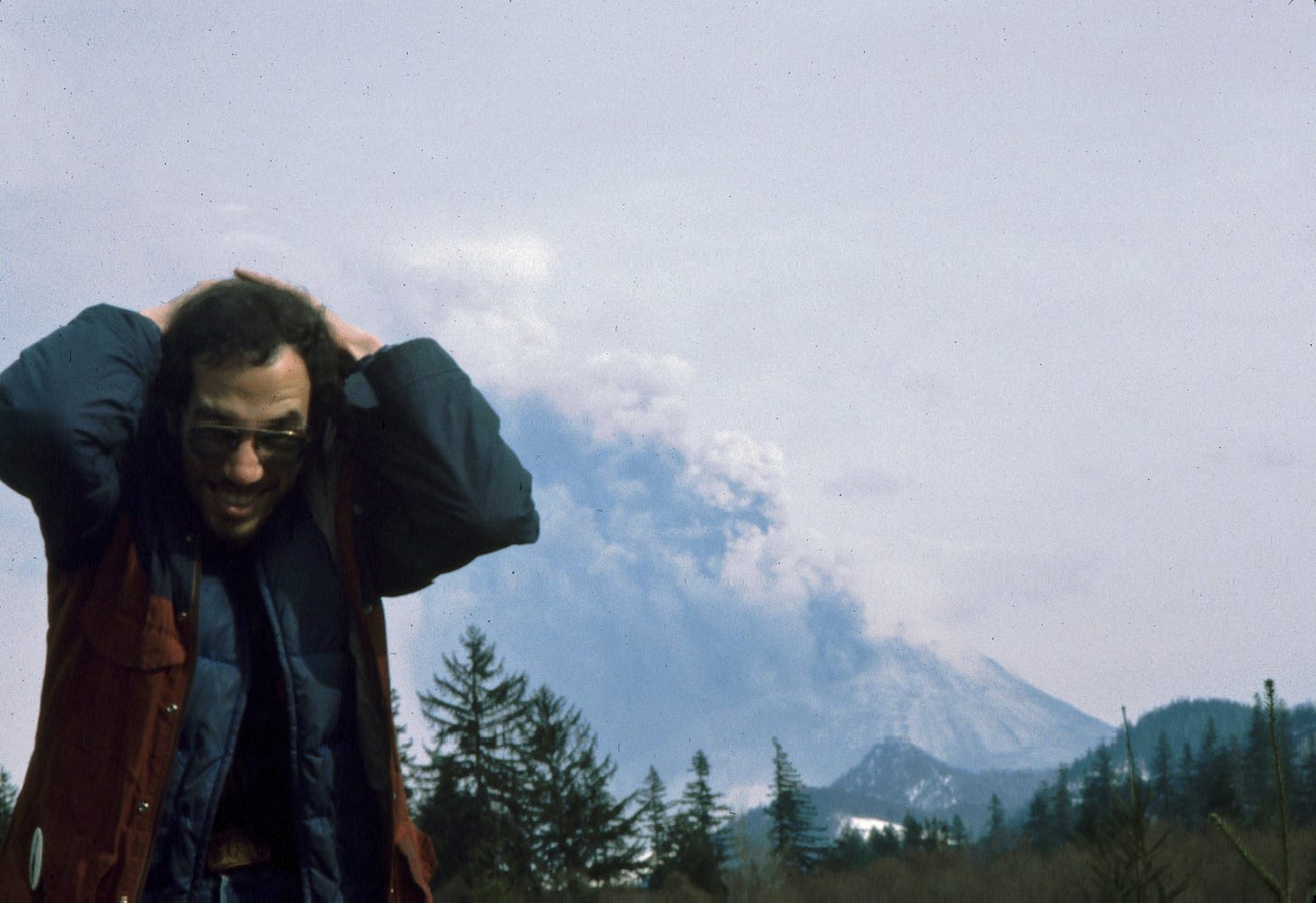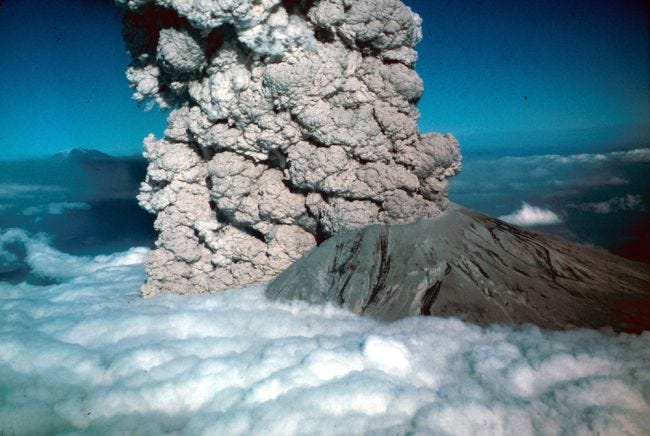
The photo above is of alert reader, Steve Laboff, who survived his close encounter with Mt. St. Helens in April of 1980. The picture was taken a month before the volcano erupted but, as you can see, it had some gastrointestinal issues for some time prior to the cataclysmic blow. I believe Steve wrote that where he stood was engulfed during the volcanic event.
I was nowhere near St Helens before or during the time of the eruption, but I do have a story to tell about that day.
On the morning of May 18, 1980, I was inflating rafts at the launch site for the Wenatchee River. Today it’s called Happy Wave Beach Club but, at the time, it was known as The Rock Cut. We had two large groups of rafters headed down the river that day. Two waves with a half dozen rafts each at two separate meet times in Cashmere. Probably 10am and 11am with a scheduled lunch stop at Dryden Dam for Orion’s delectable river side fare including my mother’s secret tuna salad sandwich recipe. (Sadly sans the hard boiled eggs because that would have been just too much trouble.)
The skies were cloudless as well as a robin’s egg blue and the weather was approaching toasty for a day in May. We were hand pumping rafts with typical guide chatter when we heard a very, very, very distant boom. I don’t know about everyone else who was there that day but the last thing I would have guessed we were hearing was one of the volcanoes in the Cascades shedding millions of tons of ash, rock and debris. It was only a brief faraway pop and nothing changed where we were.
The sun kept shining. The birds kept chirping. The river kept flowing. And there were guests awaiting us at the meeting site.
St Helens lies about 200 miles southwest from Leavenworth. The volcano is on the western side of the North Cascades mountain range. These being the days before the internet and cellphones we and our customers went about the day just as if it was any other day of the whitewater season.
I was booked in Seattle with KIRO radio that evening. I was appearing on the local outdoor talk show to talk about whitewater and river trips. For that reason, I guided the earlier trip in order to have the time to get off the river and return to Seattle in time for the interview.
As my float trip was nearing the takeout in Cashmere, twelve miles downstream from the Rock Cut launch and about eight miles upstream from the town of Wenatchee, I could see some of the blackest clouds I’ve ever seen hanging over the Columbia Valley. The skies above me remained as blue as Paul Newman’s eyes. I thought it exceedingly strange that ‘weather’ looked like it would be coming from the east. I don’t know how atypical that is, but I had never seen clouds moving east to west up the Wenatchee Valley.
Still, I thought little about it because I was in a hurry to get off the river and back to Seattle.
Later I learned from guides in the second float that, by the time they were approaching the finish in Cashmere, the black clouds were upon them and were raining down so much ash they had to turn the rafts around and make their way downstream stern first to keep the ash out of the customers’ eyes, mouths and nasal membranes. I continued blissfully unaware as I drove back to Seattle over one of the only mountain passes that not been closed due to ash fall.
I was blissfully unaware, not only because this was before the age of instant information, but because whatever rafting vehicle I was driving did not have a working AM or FM radio
I’ll let the LiveScience website describe the destruction that happened as we were riding the waves of the Wenatchee, water fighting and enjoying the sunshine of eastern Washington:
The abrupt release of pressure over the magma chamber created a “nuée ardente,” a glowing cloud of superheated gas and rock debris blown out of the mountain face moving at nearly supersonic speeds. Everything within eight miles of the blast was wiped out almost instantly, according to USGS. The shockwave rolled over the forest for another 19 miles, leveling century-old trees; all the trunks neatly aligned to the north. Beyond this “tree down zone” the forest remained standing but was seared lifeless. The area devastated by the direct blast force covered an area of nearly 230 square miles (596 square kilometers).
Shortly after the lateral blast, a second, vertical explosion occurred at the summit of the volcano, sending a mushroom cloud of ash and gases more than 12 miles (19 km) into the air. Over the next few days, an estimated 540 million tons (490,000 kilotons) of ash drifted up to 2,200 square miles (5,700 square km), settling over seven states.
The heat of the initial eruption melted and eroded the glacial ice and snow around the remaining part of the volcano. The water mixed with dirt and debris to create lahars, or volcanic mudflows. According to USGS, the lahars reached speeds of 90 mph (145 km/h), and demolished everything in their path. Most of the glaciers surrounding Mount St. Helens melted, too, and likely contributed to the destructive lahars, Benjamin Edwards, volcanologist and professor of Earth Science at Dickinson College in Pennsylvania, told Live Science in an email.
The devastation was remarkable. The disruption was also remarkable. I saw a comment by a scientist who worked for the Washington state governor at the time and he was comparing it as an emergency in a microcosmic scale to the current pandemic. Because St Helens had been rumbling for some time and even after it exploded - going from one of the highest peaks in the Cascades to the one of the lowest - no one knew if it would erupt again. Spewing even more ash throughout the region making it impossible to get around.
Seattle did not get hit by ash. Stevens Pass, the pass I used to reach Seattle, never had to close.
I made it to my hour long interview at KIRO. After the host asked me a few questions, and I spoke about rafting in my monotone, laidback voice that did not jibe with the “Breaking News” aspect of all the volcano reports, he opened it up to call in questions.
No one asked about rafting. It was the furthest thing from their mind. In 1980, KIRO was a trusted news source.
It was the quintessential Catch 22.
I had been booked on the radio at a time when thousands of potential customers were tuned in, but none of them were listening because of the rafting guy with a voice that could replace Ambien.
C’est la vie.
###
Additionally, from the LiveScience website:
The 1980 Mount St. Helens eruption was the most destructive in U.S. history. Fifty-seven people died, and thousands of animals were killed, according to USGS. More than 200 homes were destroyed, and more than 185 miles of roads and 15 miles of railways were damaged. Ash clogged sewage systems, damaged cars and buildings, and temporarily shut down air traffic over the Northwest. The International Trade Commission estimated damages to timber, civil works and agriculture to be $1.1 billion. Congress approved $950 million in emergency funds to the Army Corps of Engineers, the Federal Emergency Management Agency and the Small Business Administration to help with recovery efforts.

I know some of you have discovered Heather Cox Richardson's Letter From an American. If you want to get dirty down in the weeds, I recommend Greg Olear’s Prevail. He is not afraid to open political cans of worms.



